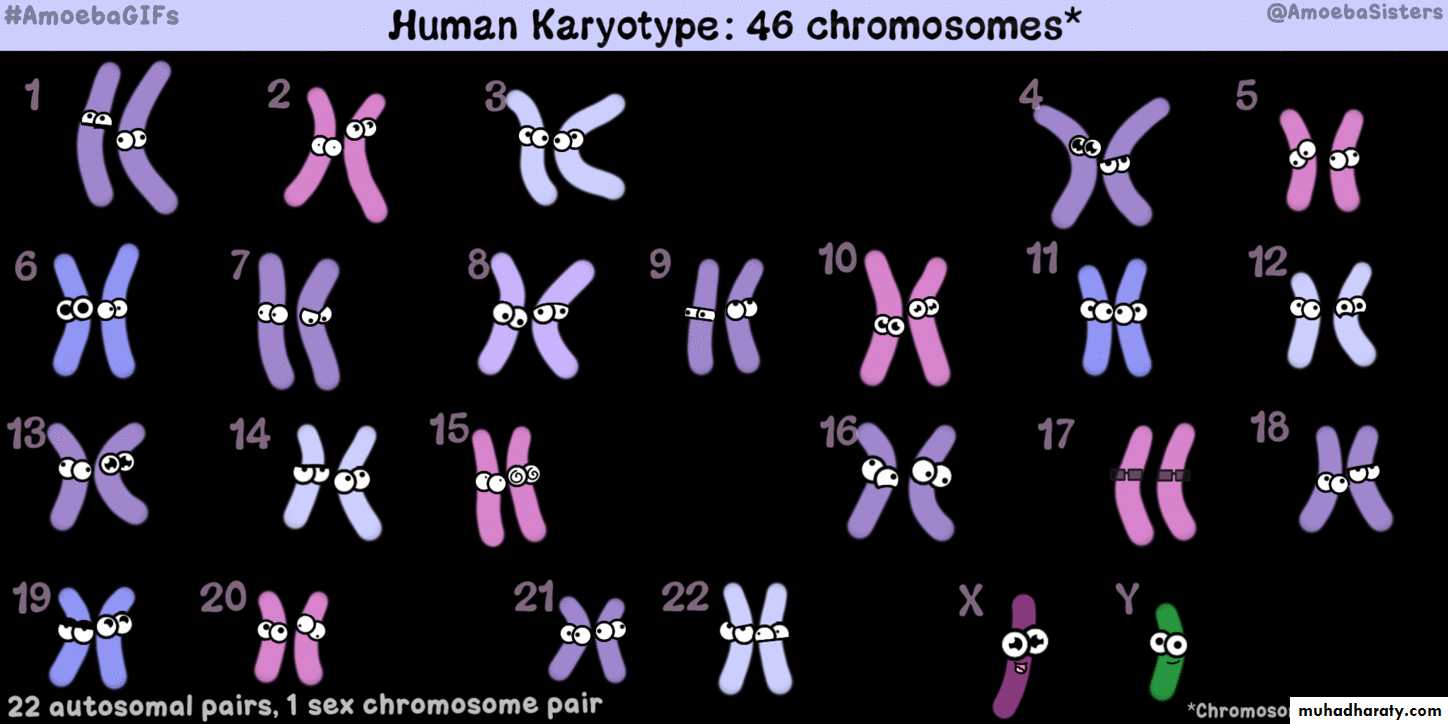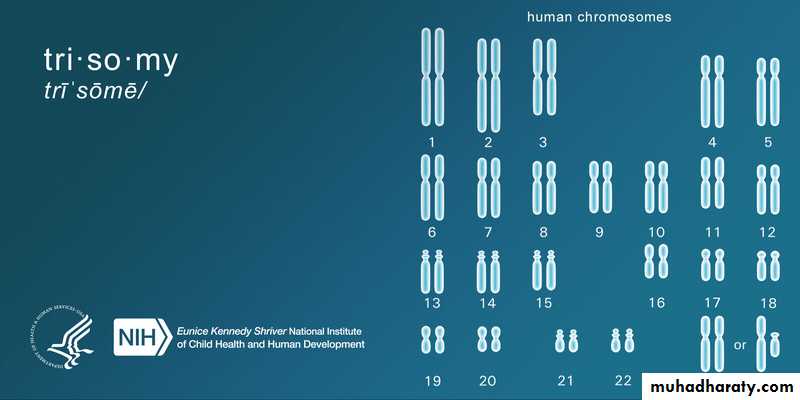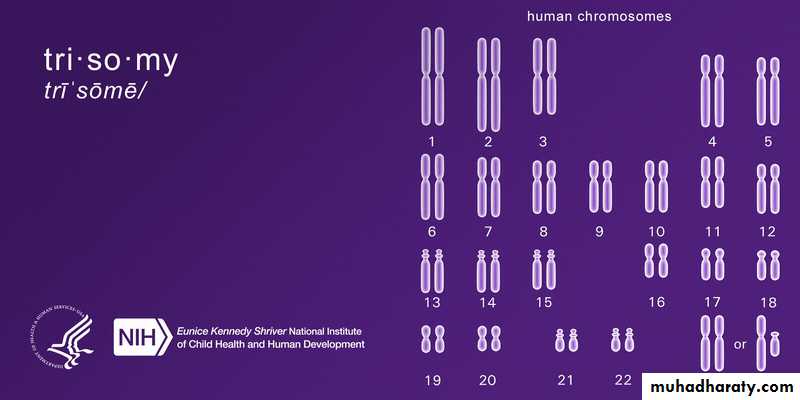GENETICS4
Cytogenetic disorders involving autosomes
Trisomy (21, 18, 13)Deletion (Cri du chat syndrome which involves chromosome 5).
Trisomy 21 (Down syndrome)It is the most common chromosomal disorder.
About 95% of affected persons have trisomy 21 (usually non-disjunction).
In 95%, the extra chromosome is maternal in origin.
The parents are normal in all respects.
Maternal age has a strong influence on the incidence which is 1 in 1550 live births in women < 20, in contrast to 1 in 25 live births in women > 45 years.
No effect of paternal age.
In 4%, the extra chromosomal material is present not as a trisomy but as a translocation of the long arm of chromosome 21 to chromosome 22 or 14. Such cases are usually familial.
Approximately 1% of trisomy 21 are mosaics, usually having a mixture of 47 & 46 chromosome cells. Symptoms in such cases are variable & milder, depending on the proportion of abnormal cells.
Downloaded from: Robbins & Cotran Pathologic Basis of Disease (on 18 July 2005 09:03 PM)
© 2005 Elsevier
Clinical Features of Down Syndrome
Cytogenetic disorders involving sex chromosomesA number of abnormal karyotypes involving sex chromosomes, ranging from 45X to 49XXXXY, are compatible with life.
On the other hand males who are phenotypically normal may have two or even three Y- chromosomes.
Klinefelter syndrome
Defined as a male hypogonadism that develops when there are at least two X chromosomes & one or more Y-chromosomes.
Most patients are 47,XXY.
The extra X may be maternal or paternal.Advanced maternal age & a history of irradiation of either parent may contribute to the condition.
Approximately 15% of patients show mosaic patterns including 46,XY/47,XXY, /48,XXXY & others. The presence of 46,XY line is associated with a milder form.
Turner syndrome (45,X0)
A primary hypogonadism in phenotypic females.Results from partial or complete monosomy of the short arm of X-chromosome.
In 57% of patients, the entire X-chromosome is missing, resulting in 45,XO karyotype. These patients are the most severely affected & can be diagnosed early in life.
Largest group among genetic disorders
Governed by the additive effects of two or more genes with a small effect & conditioned by environmental influences.Involved in many physiologic characteristics of human like height, weight, blood pressure, hair color.
Disorders of multifactorial inheritance (polygenic)
The frequency of concordance for both identical twins is significantly less than 100 % (20-40%), but is much greater than the chance of non identical twins.
Expression of the disorder depends on when the combined influences of genes and environmental factors cross a certain threshold.
E.g. Hypertension, diabetes mellitus, gout, cleft lips, cleft palates and pyloric stenosis, congenital heart diseases, cancer.
Single gene disorders with Non-Classic (Atypical) pattern of inheritance.
Four groups of diseases resulting from mutations affecting single genes do not follow mendelian inheritance.Diseases caused by triplet repeat mutations (e.g. fragile X syndrome, & myotonic dystrophy).
Diseases caused by mutations in mitochondrial genes.
Disease associated with genomic imprinting.
Disorders associated with gonadal mosaicism
Fragile X syndrome
Characterized by a long repeating sequence of three nucleotides of X-chromosome.
It is one of the most common causes of familial mental retardation.
Frequency of 1 in 1550 for affected males and 1 in 8000 of affected females
Clinically affected males have moderate to severe mental retardation.The mutated gene is on Xq.
In normal population the number of CGG repeat in is small (within 29), whereas affected individuals have 230-4000 repeats.
Carrier males & females have premutations (characterized by 52-230 CGG repeats).
Unlike patients with other X-linked recessive disorders, approximately 20% of males carrying the mutated gene are clinically normal.These carrier males can transmit the disease to their grandsons through their phenotypically normal daughters they are called "transmitting males".
Another peculiarity is the presence of mental retardation in 50% of carrier females.
Risk of phenotypic effect, the risk depends on the position of the individual in the pedigree.
Brothers of transmitting males are at 9% risk of having mental retardation. Where as grandsons carry 40% risk. This is called Sherman paradox.
Anticipation, clinical features worsen with each successive generation
The unusual features have been related to the dynamic nature of the mutation.
Diseases caused by mutations in the mitochondrial genes
There are 37 mitochondrial genes
Inheritance of mitochondrial DNA differs from that of nuclear DNA in that the mitochondrial type is associated with maternal inheritance resulting from the fact that the ova contain mitochondria within their abundant cytoplasm, whereas the spermatozoa contain few if any.
Mothers transmit mitochondrial genes to all of their offspring (males & females). However, daughters (not sons) transmit these genes further to their progeny.
Because mt DNA encodes enzymes involved in oxidative phosphorylation, mutations affecting these genes exert their effects primarily on the organs most depend on this process, like CNS, skeletal muscles, cardiac muscles, liver and kidneys.
A minimum number of mutant mt DNA must be present in a cell or tissue before oxidative dysfunction gives rise to disease. This is called "threshold effect".
Diseases associated with mitochondrial inheritance are rare and many of them affect the neuro-muscular system.
An example is Leber hereditary optic neuropathy.
Genomic imprintingTurning genes on and off
All humans inherit two copies of each gene (maternal & paternal).
In many genes there is no difference between the two. However, functional differences exist in some genes. These differences arise from an epigenetic process called genomic imprinting, where certain genes are differentially inactivated during gametogenesis.
Maternal imprinting implies that the maternal allele is inactivated,
whereas the paternal imprinting refers to transcriptional silencing of the paternal allele.
Imprinting occurs in ovum or sperm & is then stably transmitted to all somatic cells.
Examples:Prader-Willi syndrome (maternal imprinting)
Angelman syndrome (paternal imprinting).
Both disorders arise from a deletion or a mistake in imprinting of a region in chromosome 15.
Gonadal Mosaicism
With every autosomal dominant disorder some patients do not have affected parents due to new mutations in either sperm or egg. Such patient's siblings are neither affected nor at increased risk of developing the disease.In some autosomal dominant disorders, E.g osteogenesis imperfecta, phenotypically normal parents have more than one affected child. This clearly violates the laws of mendelian inheritance. Studies indicate that gonadal mosaicism may be responsible for such unusual pedigrees
Gonadal mosaicism may be responsible for this which is due to mutation that occurs postzygotically during early embryonal development.
If the mutation affects only cells designed to form gonads, the gametes carry the mutation, but the somatic cells are completely normal. Such an individual is said to exhibit gonadal mosaicism.
A phenotypically normal parent who has germ line mosaicism can transmit the disease-causing mutation to the offspring's through the mutant gamete, and there is a definite possibility that more than one child of such a parent would be affected.
Aim of study of genetic diseases
Disease diagnosisGene therapy
Diagnostic application
DNA probes can be powerful tools for the diagnosis of human disease, both genetic and acquired, which include:Detection of inherited mutations that underlie the development of genetic diseases either prenatally or at birth.
Detection of acquired mutations that underlie the development of neoplasms.
Accurate diagnosis and classification of neoplasms, especially of hematopoietic system.
Diagnosis of infectious diseases.
Determination the relatedness and identity in transplantation, paternity testing and forensic medicine.
In the future, detection of polymorphisms disease.
Diagnosis of genetic diseases
Diagnosis of genetic diseases requires examination of genetic material (chromosomes and genes)Cytogenetic analysis (Chromosomal abnormalities) (karyotypic)
Molecular analysis (Gene abnormalities)Prenatal chromosome analysis should be offered to all patients who are at risk of cytogenetically abnormal progeny.
It can be performed on cells obtained by:
1. Pre-implantation Diagnosis
2. Maternal Blood Test (14-20 weeks)3. Amniocentesis (15-17 weeks)
4. Chorionic Villus Test (8-11 weeks)
5. Fetal blood (umbilical cord blood)
Postnatal chromosome analysis is usually performed on peripheral blood lymphocytes
Multiple congenital anomalies.Unexplained mental or physical retardation.
Suspected aneuploidy (Down syndrome).
Suspected sex chromosome abnormality (turner syndrome).
Suspected fragile X-syndrome.
Infertility, to rule out sex chromosome abnormality.
Multiple spontaneous abortions..
Some important indications are
Advanced maternal age (more than 34 years), because of greater risk of trisomies.A parent who is a carrier of structurally abnormal chromosome.
A parent with a previous child with a chromosomal abnormality.
A parent who is a carrier of an X-linked genetic disorder (to determine the fetal sex).
Molecular analysis
To detect subtle changes in individual genes by using recombinant DNA technology.Prenatally, amniotic fluid or biopsy of chorionic villi is used as early as the first trimester.
Postnatally, tiny amount of whole blood or even dried blood can supply sufficient DNA for PCR amplification.
• Methods used for diagnosis
• Techniques used• Hybridization
• PCR(polymerase chain reaction)
• Microarray
• Others





